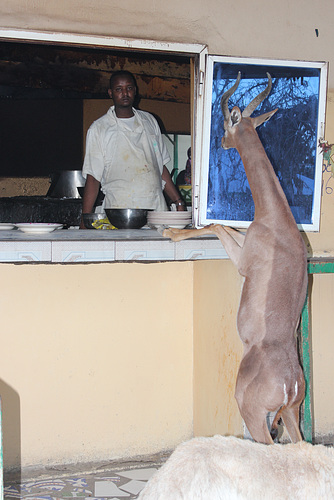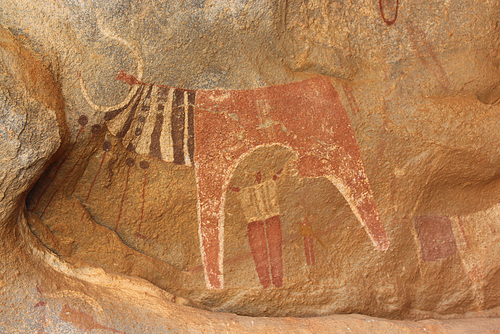4 to 9 January, 2015 - Hargeisa, Las Geel, Berbera - (Somaliland)
Our time in Somaliland was far more about meeting and interacting with Somali people than sight-seeing. So, it is appropriate, then, that the blog is more about our observations than about what we did.
Let's start with the big plus. Somalis are welcoming. Somalilanders in particular are happy to include comments about how safe Somaliland is. The level of English spoken, particularly in Hargeisa, is reasonable. So many people stop us for a three or four sentence conversation. Many. At least every two or three minutes. And not just people walking. Drivers too. They stop, wind down the window, and commence a conversation, while traffic builds up, until finally a few toots from the other cars cause them to wave good-bye and drive on. "Hello. Where are you from? What is your name? Are you tourists? How is Somaliland? How long are you visiting Somaliland? Is this your wife/husband?" Choose from these questions, and add one or two extras, and these are how the conversations go.
While on the topic of cars and drivers, Somalilanders drive on the right hand side of the road, like most countries in this part of the world, but until two years ago, they drove on the left like many former British colonies. So, the large majority of cars are still right hand drive, and the buses all have doors requiring passengers to go to the middle of the road to get on.
Travelling far from Hargeisa is not possible without permits and military escort. Thankfully, these are not prohibitively expensive, but proportionally they throw the expenditure up quite a bit. I was disappointed our soldier for Las Geel wasn't a bit more interactive. He sat in the front, machine gun across his knee, while the driver talked (yelled) in Somali, and he nodded along with "Ha, Ha". "Ha" seems to be a fairly common note of agreement when talking. Interestingly, when the Somali men talk amongst themselves, it almost always appears hostile. Voices are raised, hands are waved, and it borders on aggresive. The driver assured us that this did not mean it was not a friendly conversation taking place, but it did make us wonder how they reacted when they had an argument.
When we arrived in Somaliland, at the land border from Ethiopia, we had to take a taxi from Wajaale (Togo-Wuchale on the Ethiopian side) to Hargeisa. We squeezed in - four adults across the three seats, for the 2-3 hour ride, which ended up taking much longer. He drove around town picking up bags of who-knows-what for delivery to the capital, then, once on our way, we had to show our passports and papers at about four different military check points. He stopped for petrol. We went through a car wash! Yes, all 11 of us sat in the van while it was washed! He had the tyre pressure checked, including the spare. He even had an express oil change and air filter clean. We got out while the service was done! We thought it quite odd to do these tasks while paying passengers were being transported, but nobody else seemed to think it unusual.
One major negative in Somaliland - the rubbish. Plastic bags everywhere. Piling up in ditches. Along roads and rivers. Caught in trees. We started calling them the "Somaliland Plastic-Bag-Fruit Trees". The attitude to throwing rubbish around was not great in Ehiopia - it is way worse in Somaliland. It was almost distressing to look out from bridges and see river beds choked with refuse.
When we came in to Somaliland, we brought loads of cash, US dollars more specifically. We tried two ATMs that claimed to handle foreign cards, but we always got the same message about communication failure. Maybe they do accept foreign cards sometimes, but not when we needed it. And why did we need it if we brought so much cash? Because we decided a flight to Djibouti would be far more comfortable than 20 hours in a 4WD taxi. We were not too short, but we were short. Finally, we managed to find a website that allowed us to make the payment for the flight with credit card - without that, we would have been in strife.
Money changers abound on the streets. Huge volumes of cash are piled high. The photo below has more about that.

Antelope Wants a Hand-out
We were at a garden setting restaurant in Hargeisa, and there were a few animals roaming; an old and wizened sheep, and a couple of antelopes. The animals obviously get occasional tit-bits from the kitchen, and when you want a hand-out, you make sure you are seen!

Money Changer - Hargeisa
A money changer sitting on a shipping palette with bricks of notes. Somaliland Shillings come in denominations of 100, 500, 1000, and 5000. Well, at least what we deal with. There are denominations smaller than 100 Shillings, but since the conversion rate is about 7000 to the US Dollar, smaller than 500 is rarely handed to us. Anyway, the point is, the largest note is worth around 80 cents, so large sums of money require huge bundles of notes.

Ancient Rock Paintings - Las Geel
A magnificent prehistoric rock canvas covered in ancient paintings. Created by pastoralists some 5000 years ago, they mainly show cows, men, and dogs. There are some other themes in the eight or so caves, including some wild animals and a couple of hunting scenes, but bovines well and truly dominate.

A Man Milking his Cow
A 5000 year old depiction of a man milking a cow. We never received a good explanation of what the colours and patterns at the neck represent, but we gather they may have wrapped some sort of cloth on their cows, or at least their important ones.
Our time in Somaliland was far more about meeting and interacting with Somali people than sight-seeing. So, it is appropriate, then, that the blog is more about our observations than about what we did.
Let's start with the big plus. Somalis are welcoming. Somalilanders in particular are happy to include comments about how safe Somaliland is. The level of English spoken, particularly in Hargeisa, is reasonable. So many people stop us for a three or four sentence conversation. Many. At least every two or three minutes. And not just people walking. Drivers too. They stop, wind down the window, and commence a conversation, while traffic builds up, until finally a few toots from the other cars cause them to wave good-bye and drive on. "Hello. Where are you from? What is your name? Are you tourists? How is Somaliland? How long are you visiting Somaliland? Is this your wife/husband?" Choose from these questions, and add one or two extras, and these are how the conversations go.
While on the topic of cars and drivers, Somalilanders drive on the right hand side of the road, like most countries in this part of the world, but until two years ago, they drove on the left like many former British colonies. So, the large majority of cars are still right hand drive, and the buses all have doors requiring passengers to go to the middle of the road to get on.
Travelling far from Hargeisa is not possible without permits and military escort. Thankfully, these are not prohibitively expensive, but proportionally they throw the expenditure up quite a bit. I was disappointed our soldier for Las Geel wasn't a bit more interactive. He sat in the front, machine gun across his knee, while the driver talked (yelled) in Somali, and he nodded along with "Ha, Ha". "Ha" seems to be a fairly common note of agreement when talking. Interestingly, when the Somali men talk amongst themselves, it almost always appears hostile. Voices are raised, hands are waved, and it borders on aggresive. The driver assured us that this did not mean it was not a friendly conversation taking place, but it did make us wonder how they reacted when they had an argument.
When we arrived in Somaliland, at the land border from Ethiopia, we had to take a taxi from Wajaale (Togo-Wuchale on the Ethiopian side) to Hargeisa. We squeezed in - four adults across the three seats, for the 2-3 hour ride, which ended up taking much longer. He drove around town picking up bags of who-knows-what for delivery to the capital, then, once on our way, we had to show our passports and papers at about four different military check points. He stopped for petrol. We went through a car wash! Yes, all 11 of us sat in the van while it was washed! He had the tyre pressure checked, including the spare. He even had an express oil change and air filter clean. We got out while the service was done! We thought it quite odd to do these tasks while paying passengers were being transported, but nobody else seemed to think it unusual.
One major negative in Somaliland - the rubbish. Plastic bags everywhere. Piling up in ditches. Along roads and rivers. Caught in trees. We started calling them the "Somaliland Plastic-Bag-Fruit Trees". The attitude to throwing rubbish around was not great in Ehiopia - it is way worse in Somaliland. It was almost distressing to look out from bridges and see river beds choked with refuse.
When we came in to Somaliland, we brought loads of cash, US dollars more specifically. We tried two ATMs that claimed to handle foreign cards, but we always got the same message about communication failure. Maybe they do accept foreign cards sometimes, but not when we needed it. And why did we need it if we brought so much cash? Because we decided a flight to Djibouti would be far more comfortable than 20 hours in a 4WD taxi. We were not too short, but we were short. Finally, we managed to find a website that allowed us to make the payment for the flight with credit card - without that, we would have been in strife.
Money changers abound on the streets. Huge volumes of cash are piled high. The photo below has more about that.

Antelope Wants a Hand-out
We were at a garden setting restaurant in Hargeisa, and there were a few animals roaming; an old and wizened sheep, and a couple of antelopes. The animals obviously get occasional tit-bits from the kitchen, and when you want a hand-out, you make sure you are seen!

Money Changer - Hargeisa
A money changer sitting on a shipping palette with bricks of notes. Somaliland Shillings come in denominations of 100, 500, 1000, and 5000. Well, at least what we deal with. There are denominations smaller than 100 Shillings, but since the conversion rate is about 7000 to the US Dollar, smaller than 500 is rarely handed to us. Anyway, the point is, the largest note is worth around 80 cents, so large sums of money require huge bundles of notes.

Ancient Rock Paintings - Las Geel
A magnificent prehistoric rock canvas covered in ancient paintings. Created by pastoralists some 5000 years ago, they mainly show cows, men, and dogs. There are some other themes in the eight or so caves, including some wild animals and a couple of hunting scenes, but bovines well and truly dominate.

A Man Milking his Cow
A 5000 year old depiction of a man milking a cow. We never received a good explanation of what the colours and patterns at the neck represent, but we gather they may have wrapped some sort of cloth on their cows, or at least their important ones.
No comments:
Post a Comment